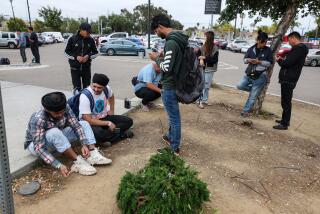Needed Reprieve in Work Plan
Under the state welfare reform law, October is the first deadline for a large group of welfare recipients in Los Angeles County to be employed or working in community public service jobs. But the county still does not have an approved jobs program in place, and these recipients, primarily mothers with young children, are being given a six-month extension on a case-by-case basis to work on their job skills. That reprieve will also give the county more time to set up an effective system.
California law requires welfare recipients to work in the public sector or for private, nonprofit employers after they have exceeded their time limit, 18 or 24 months depending on when they started receiving aid. Otherwise, the law says, benefits are to be cut off. But before the county Community Service Work program can be established in Los Angeles County, the Board of Supervisors must decide whether welfare recipients must work in exchange for a welfare check or get a paycheck.
The board has asked welfare officials to figure the difference between a grant-based program, which would require no additional administrative costs, and a wage-based program. That shouldnât be a hard decision for the board; welfare reform was predicated on the idea that recipients ought to earn their benefits and become self-sufficient. The paycheck approach--used by San Francisco, Oakland, Seattle, Detroit and other cities--would cost more, but it would also give recipients a work history, qualify them for the federal earned-income tax credit and perhaps lead to better jobs.
When the jobs program is up and running it will be expected to provide work for recipients who are hard to employ, primarily the poorly educated and unskilled with no work history or those with large families that require complicated child care arrangements.
The majority of skilled welfare recipients have already found jobs in the busy local economy or through the help of welfare-to-work programs. Since April 1998, when the state approved the Cal Works program, more than 60,000 L.A. County recipients have found full- or part-time work. Because those numbers exceed state goals, the county has received more than $154 million in so-called âperformance incentiveâ awards. How that money will be spent will also be determined by the supervisors, but their first priority should be setting up a community service work program that can accommodate the thousands of welfare recipients who are expected to run out of time.
More to Read
Sign up for Essential California
The most important California stories and recommendations in your inbox every morning.
You may occasionally receive promotional content from the Los Angeles Times.










